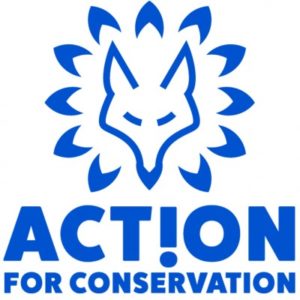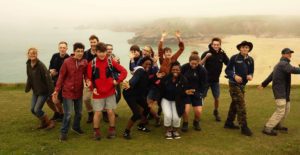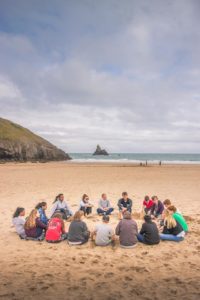“Building the next generation of Nature Conservationists”
Hendrikus_van_Hensbergen
An outdoor talk with Hendrickus van Hensbergen
How often do you meet entrepreneurs making a change for nature?

Action for conservation logo
Hendrickus van Hensbergen was an invited speaker at the EUROPARC Conference 2018 and we could not miss the opportunity to talk to him in person. Founder and Chief Executive Officer of the charity “Action for Conservation”, Hendrikus is not only a young entrepreneur working for conservation – he is inspiring other youngsters to lead the change.
Despite his Dutch name, Hendrikus grew up sharing his time between the UK’s South-West Jurassic Coast and the Guadarrama Mountains in Spain. “As a child, I remember collecting vulture feathers and catching lizards”, revealed Hendrikus with sparkling eyes. Growing up in such iconic landscapes has certainly shaped his character and triggered his career choices – his passion for nature led him down a path into zoology and conservation. Now, he spends his time engaging with youngsters in schools and camps, enabling them to connect to nature. As he explained, “by 2030, 92,2% of the UK’s population will be living in cities, so we need to think about ways to get young people out to enjoy natural spaces, otherwise they won’t value or care for them”.
EUROPARC Federation (E): What made you start the charity “Action for Conservation”?
Hendrikus (H): In my previous job at WWF, I had the chance to visit my old secondary school. I went with some quite lazy assumptions about young people and how they would engage with environmental issues – in my case, I was not really aware of them until late into my teens. Also, the image presented by the press about young teens is quite negative: addicted to technology, disengaged, disinterested… but I found completely the opposite.
They were really inspiring and keen to learn and that sparked something in me. What if we could harness the energy and ideas of young people? Particularly in England and Wales, there are very few approaches that really target teenagers – it was a bit of a niche, a gap that was not being filled.
Understanding this made me join forces with fellow young conservationists. We started out as a project going to schools to speak to young people from different backgrounds. And that’s really how the charity began, just as a network of young people interested in engaging other young people in environmental issues.
(E) How are you engaging young people?
(H) We believe that all young people should feel moved and empowered to protect the natural world and so we developed three programmes for youngsters. The main one, which also reaches a broader audience, is developed in secondary schools, particularly in disadvantaged urban areas. The second programme is our residential camp, which is a much more immersive experience, taking place in national parks, where we bring young people to spend time together and connect with nature. Lastly, we have an ambassador programme, which is a year-long programme to mentor and support young individuals taking action in their communities.

Photo with the courtesy of Action for Conservation
(E) Can you tell us more about the programme with secondary schools?
(H) Our schools’ work is focused on engaging a wide spectrum of society. The aim is to inspire the youngsters and support them in designing and delivering their own projects so they can have a real impact in their community and feel a sense of success.
We would go into three workshops with the same group of students, over a school term. The 1st workshop is all about inspiration, it’s very active as we are building knowledge and interest levels. In the next workshops, we support them in designing and implementing their projects, which they present back in the end. If they were successful, they go through a final event with several schools, where they share their achievements.
(E) This means that the students, in the end, are making a real contribution in their communities…?
(H) Yes, we try to focus on local issues and partner as much as possible with other conservation organisations working locally, so that young people can have meaningful action and impact. Addressing something place-based, which is relevant for their area and community, is essential. If you are not connected with your local place, then it is hard to be connected to anything else.
(EU) What have you learned on the way?
(H) I have learned how to fundraise, which is very challenging – there are limited pots of money and typically, funds in the UK have been quite focused on particular areas – it might be children and young people, it might be environment, and they would not necessary fund things that sit at the intersection between these two. To start the Charity, for example, we had to find an alternative solution and made it through a crowd-funding campaign.
There are also a lot of challenges around working with schools. Teachers are under a lot of pressure and have in average 8 seconds to read an email, so you really have to be quite sharp on how to get teachers on board and get their interest.
Working with young people is amazing but can be challenging. We work with theatre professionals to make our workshops more interactive and not rely on boring PowerPoints – that’s how what we do sticks with them.
(E) What would be your 3 pieces of advice for Young people?

Photo with the courtesy of Action for Conservation
(H) First, find your passion and hold on to it, it does not necessarily have to be conservation. Following your passion is not easy – it might not always mean money or a certain life style, but it will give you fulfilment!
Second, take action. If you feel like something needs to change and there is no mechanism to change it through other organisations or normal routes, you need to take the risk and take action. That is in essence what happened with the charity. I started a project to fulfil a need, to fill a gap, and everything kind of evolved out of that.
Third, build a community around you – they will be your support and will make things happen. But be willing to work really hard! Built up slowly and steadily, because it will give you a stronger base and thus, will be more likely to work. Take things slowly, let them evolve naturally.
(E) So far, you have mainly been working with national parks in England and Wales. How do you see a future cooperation with EUROPARC and other European Protected Areas?
(H) We are keen to work with organisations to put young people at the centre of decision-making – it is the only way they will feel empowered for protected areas to become a part of their identity. We see ourselves as facilitators: what we have is a layered model that is effective and can be adapted to different contexts across Europe. I have been taking it to other places, and I would be very interested in doing it also with other EUROPARC members.
Watch EUROPARC Live Video with Hendrickus’ full interview!
For more information visit http://www.actionforconservation.org/
You found this topic interesting? To find more articles like this one, download the new edition of the EUROPARC Journal Protected Areas In-Sight with a special focus on youth involvement Parks – available in english, german and french!